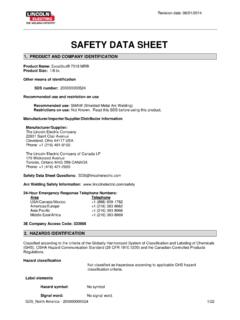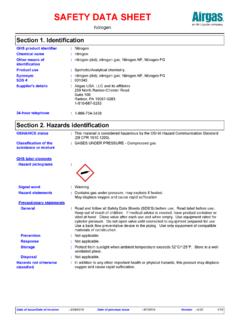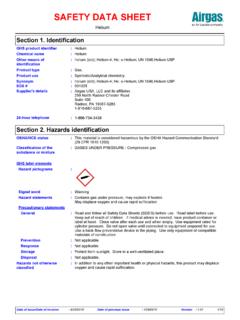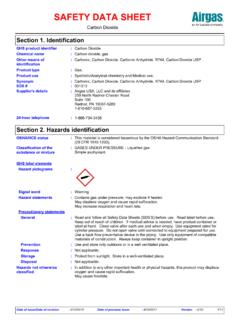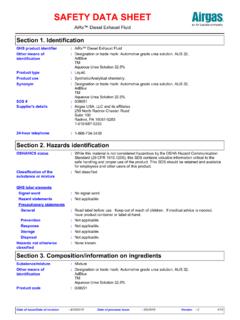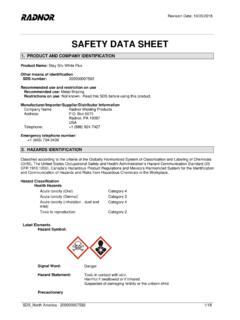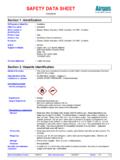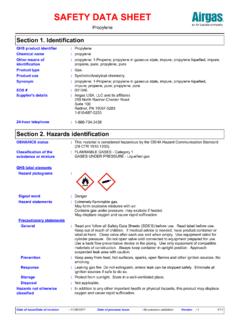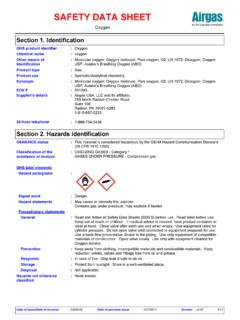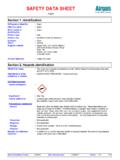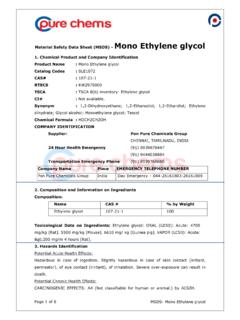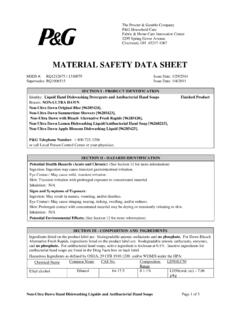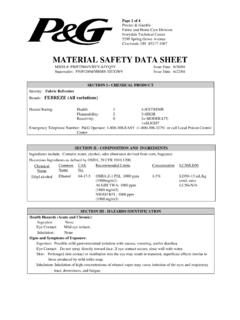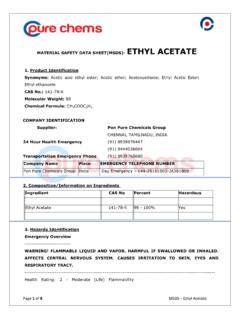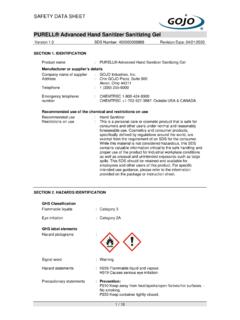Transcription of SAFETY DATA SHEET
1 Ethanolethyl alcohol; ALCOHOL; ethyl alcohol (Ethanol); EtOH; Grain alcohol; Cologne spirit;Denatured Alcohol; METHYLCARBINOL; Ethanol in alcoholic beverages; Methylated Spirits; ethyl data SHEETGHS product identifierOther means of identificationProduct typeSection 1. Identification:::Chemical name:ethanolSupplier's details:EthanolProduct use:Synthetic/Analytical : ethyl alcohol; ALCOHOL; ethyl alcohol (Ethanol); EtOH; Grain alcohol; Cologne spirit;Denatured Alcohol; METHYLCARBINOL; Ethanol in alcoholic beverages; Methylated Spirits; ethyl hydroxideSDS #:001114 airgas USA, LLC and its affiliates259 North Radnor-Chester RoadSuite 100 Radnor, PA 19087-52831-610-687-52531-866-734-3438:2 4-hour telephoneSection 2. Hazards identificationFLAMMABLE LIQUIDS - Category 2 Classification of the substance or mixture:Signal word:DangerHazard statements:May form explosive mixtures with flammable liquid and pictograms:Precautionary statementsPrevention:Wear protective gloves.
2 Wear eye or face protection. Keep away from heat, sparks,open flames and hot surfaces. - No smoking. Use explosion-proof electrical, ventilating,lighting and all material-handling equipment. Use only non-sparking tools. Take precautionary measures against static discharge. Keep container tightly closed. Use and store only outdoors or in a well ventilated :IF ON SKIN (or hair): Take off immediately all contaminated clothing. Rinse skin with water or :Store in a well-ventilated place. Keep :Dispose of contents and container in accordance with all local, regional, national and international label elementsGeneral:Read label before use. Keep out of reach of children. If medical advice is needed,have product container or label at not otherwise classified:None status:This material is considered hazardous by the OSHA Hazard Communication Standard (29 CFR ).Date of issue/Date of revision:4/8/2019 Date of previous issue:No previous validationVersion:11/12 EthanolSection 3.
3 Composition/information on ingredientsethanol10064-17-5 Ingredient nameCAS number%There are no additional ingredients present which, within the current knowledge of the supplier and in the concentrations applicable, are classified as hazardous to health or the environment and hence require reporting in this name:ethanolOther means of identification: ethyl alcohol; ALCOHOL; ethyl alcohol (Ethanol); EtOH; Grain alcohol; Cologne spirit;Denatured Alcohol; METHYLCARBINOL; Ethanol in alcoholic beverages; Methylated Spirits; ethyl hydroxideCAS number:64-17-5 Substance/mixtureCAS number/other identifiers:Occupational exposure limits, if available, are listed in Section concentration shown as a range is to protect confidentiality or is due to batch code:001114 Wash out mouth with water. Remove dentures if any. Remove victim to fresh air and keep at rest in a position comfortable for breathing.
4 If material has been swallowed and the exposed person is conscious, give small quantities of water to drink. Stop if the exposed person feels sick as vomiting may be dangerous. Do not induce vomiting unless directed to do so by medical personnel. If vomiting occurs, the head should be kept low so that vomit does not enter the lungs. Get medical attention if adverse health effects persist or are severe. Never give anything by mouth to an unconscious unconscious, place in recovery position and get medical attention an open airway. Loosen tight clothing such as a collar, tie, belt or flush eyes with plenty of water, occasionally lifting the upper and lower eyelids. Check for and remove any contact lenses. Continue to rinse for at least 10 minutes. Get medical attention if irritation contaminated skin with plenty of water. Remove contaminated clothing and shoes. Get medical attention if symptoms occur.
5 Wash clothing before reuse. Clean shoes thoroughly before victim to fresh air and keep at rest in a position comfortable for breathing. If not breathing, if breathing is irregular or if respiratory arrest occurs, provide artificial respiration or oxygen by trained personnel. It may be dangerous to the person providing aid to give mouth-to-mouth resuscitation. Get medical attention if adverse health effects persist or are severe. If unconscious, place in recovery position and get medical attention immediately. Maintain an open airway. Loosen tight clothing such as a collar,tie, belt or 4. First aid measuresEye contactSkin contactInhalationIngestion::::Descriptio n of necessary first aid measuresMost important symptoms/effects, acute and delayedInhalation:No known significant effects or critical known significant effects or critical hazards.:IngestionSkin contact:No known significant effects or critical known significant effects or critical hazards.
6 :Eye contactOver-exposure signs/symptomsSkin contactInhalationNo specific specific data .::Eye contact:No specific acute health effectsFrostbite:Try to warm up the frozen tissues and seek medical of issue/Date of revision:4/8/2019 Date of previous issue:No previous validationVersion:12/12 EthanolSection 4. First aid measuresProtection of first-aiders:No action shall be taken involving any personal risk or without suitable training. It may be dangerous to the person providing aid to give mouth-to-mouth to physician:Treat symptomatically. Contact poison treatment specialist immediately if large quantities have been ingested or treatments:No specific specific data .:See toxicological information (Section 11)Indication of immediate medical attention and special treatment needed, if necessarySection 5. Fire-fighting measuresPromptly isolate the scene by removing all persons from the vicinity of the incident if there is a fire.
7 No action shall be taken involving any personal risk or without suitable training. Move containers from fire area if this can be done without risk. Use water spray to keep fire-exposed containers thermal decomposition productsSpecific hazards arising from the chemicalDecomposition products may include the following materials:carbon dioxidecarbon monoxideHighly flammable liquid and vapor. Runoff to sewer may create fire or explosion a fire or if heated, a pressure increase will occur and the container may burst, with the risk of a subsequent explosion. The vapor/gas is heavier than air and will spread along the ground. Vapors may accumulate in low or confined areas or travel a considerable distance to a source of ignition and flash should wear appropriate protective equipment and self-contained breathing apparatus (SCBA) with a full face-piece operated in positive pressure protective equipment for fire-fightersUse dry chemical, CO , water spray (fog) or media:::Do not use water extinguishing media:Unsuitable extinguishing media:Special protective actions for fire-fighters:Section 6.
8 Accidental release measuresEnvironmental precautionsPersonal precautions, protective equipment and emergency procedures::No action shall be taken involving any personal risk or without suitable surrounding areas. Keep unnecessary and unprotected personnel from entering. Do not touch or walk through spilled material. Shut off all ignition flares, smoking or flames in hazard area. Avoid breathing vapor or mist. Provide adequate ventilation. Wear appropriate respirator when ventilation is inadequate. Put on appropriate personal protective dispersal of spilled material and runoff and contact with soil, waterways, drains and sewers. Inform the relevant authorities if the product has caused environmental pollution (sewers, waterways, soil or air).Stop leak if without risk. Move containers from spill area. Use spark-proof tools and explosion-proof equipment. Dilute with water and mop up if water-soluble.
9 Alternatively,or if water-insoluble, absorb with an inert dry material and place in an appropriate waste disposal container. Dispose of via a licensed waste disposal spill:Methods and materials for containment and cleaning upFor non-emergency personnelFor emergency responders:If specialized clothing is required to deal with the spillage, take note of any information in Section 8 on suitable and unsuitable materials. See also the information in "For non-emergency personnel".Date of issue/Date of revision:4/8/2019 Date of previous issue:No previous validationVersion:13/12 EthanolSection 6. Accidental release measuresStop leak if without risk. Move containers from spill area. Use spark-proof tools and explosion-proof equipment. Approach release from upwind. Prevent entry into sewers,water courses, basements or confined areas. Wash spillages into an effluent treatment plant or proceed as follows.
10 Contain and collect spillage with non-combustible,absorbent material sand, earth, vermiculite or diatomaceous earth and place in container for disposal according to local regulations (see Section 13). Dispose of via a licensed waste disposal contractor. Contaminated absorbent material may pose the same hazard as the spilled product. Note: see Section 1 for emergency contact information and Section 13 for waste spill:Section 7. Handling and storageAdvice on general occupational hygieneConditions for safe storage,including any incompatibilitiesEating, drinking and smoking should be prohibited in areas where this material is handled, stored and processed. Workers should wash hands and face before eating,drinking and smoking. Remove contaminated clothing and protective equipment before entering eating areas. See also Section 8 for additional information on hygiene in accordance with local regulations.
